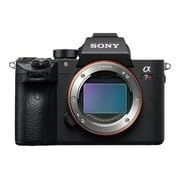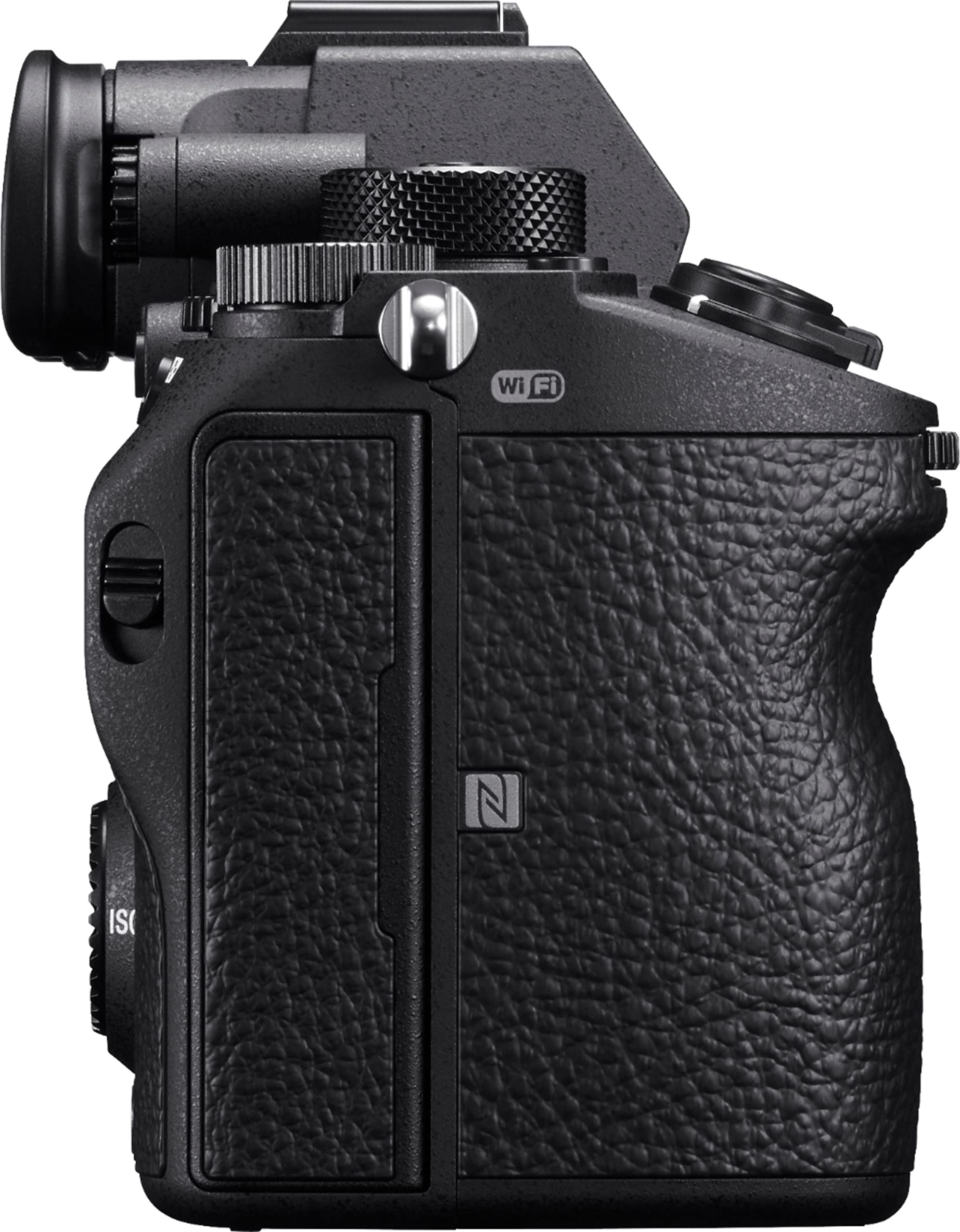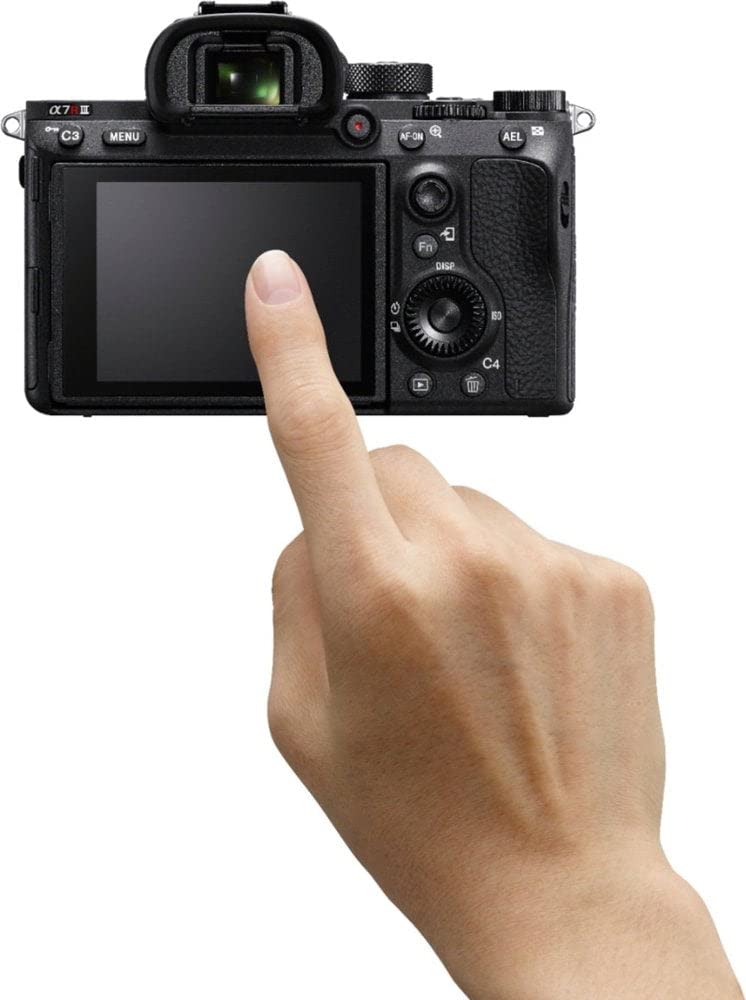








🚀 Elevate Your Vision with Sony Alpha 7R III – Where Speed Meets Stunning Detail!
The Sony Alpha 7R III is a professional mirrorless camera featuring a 42.4MP full-frame Exmor R CMOS sensor, BIONZ X image processor, and advanced autofocus with 425 points. It delivers up to 10fps continuous shooting, 4K HDR video recording, and includes dual UHS-II SD card slots for extended shooting. With a 3-inch tilting LCD, 5-axis sensor-shift stabilization, and comprehensive connectivity options, it’s designed for photographers and videographers demanding high resolution, speed, and versatility.
| Metering Methods | Center-Weighted Average, Highlight Weighted, Multi-Zone, Spot |
| Exposure Control | Aperture Priority, Auto, Manual, Program, Shutter Priority |
| White Balance Settings | Auto, Incandescent, Daylight, Color Temperature, Underwater, Fluorescent, Custom, Cloudy, Shade |
| Self Timer | 2 seconds, 10 seconds, 5 seconds |
| Crop Mode | Full-Frame |
| Screen Size | 3 Inches |
| Display Type | LCD |
| Dots Per Screen | 2,359,296 Dot |
| Display Fixture Type | Tilting |
| Display Resolution Maximum | 1920 x 1080 |
| Has Color Screen | Yes |
| Flash Memory Type | Slot 1: SD/SDHC/SDXC (UHS-II)Slot 2: SD/SDHC/SDXC/Memory Stick Duo Hybrid (UHS-I) |
| Memory Slots Available | 2 |
| Recording Capacity | 30 minutes |
| Flash Memory Speed Class | UHS-I |
| Flash Memory UHS Speed Class | UHS-II |
| Compatible Mountings | Sony E |
| Sensor Type | CMOS |
| Image stabilization | Sensor-shift |
| Maximum Aperture | 4 f |
| Expanded ISO Minimum | 50 |
| Photo Sensor Resolution | 42.4 MP |
| Photo Sensor Size | Full Frame (35mm) |
| Maximum Shutter Speed | 30 seconds |
| Minimum Shutter Speed | 1/8000 seconds |
| Form Factor | Mirrorless |
| Special Feature | BIONZ X Image Processor and Front-End LSI; 399-Point AF System; 5-Axis SteadyShot INSIDE Stabilization |
| Color | Black |
| Item Weight | 1.5 Pounds |
| Video Resolution | 4320p |
| Viewfinder | Electronic |
| Flash Modes | Auto, Fill Flash, Hi-Speed Sync, Off, Rear Sync, Red-Eye Reduction, Slow Sync, Wireless |
| Camera Flash | Hotshoe |
| Skill Level | Professional |
| Specific Uses For Product | Photography, Videography |
| Continuous Shooting | 10 fps |
| Viewfinder Magnification | 0.78x |
| Audio Input | Built-in microphone |
| Flash Sync Speed | 1/250 Second |
| Video Capture Format | XAVC S/AVCHD/MP4 |
| Expanded ISO Maximum | 102400 |
| Battery Weight | 3 Ounces |
| Delay between shots | 0.1 seconds |
| Audio Output Type | Headphones |
| Battery Cell Type | Lithium Ion |
| Battery Type | Lithium Ion |
| Aspect Ratio | 16:9, 3:2 |
| File Format | JPEG, Raw |
| Effective Still Resolution | 42.4 MP |
| JPEG Quality Level | Basic, Fine, Normal |
| Supported Image Format | JPEG, RAW |
| Bit Depth | 14 Bit |
| Total Still Resolution | 42.4 MP |
| Optical Zoom | 1 x |
| Lens Type | Wide Angle |
| Zoom | Digital Zoom |
| Minimum Focal Length | 1.25 Feet |
| Focal Length Description | 24-70 millimeters |
| Digital Zoom | 4 x |
| Number of Diaphragm Blades | 9 |
| Photo Filter Thread Size | 77 Millimeters |
| Lens Construction | 17 Elements in 14 Groups |
| Photo Filter Size | 77 Millimeters |
| Connectivity Technology | Bluetooth, Wi-Fi, USB, HDMI, NFC |
| Wireless Technology | Bluetooth, Wi-Fi |
| Video Output | Micro-HDMI |
| Total USB 2.0 Ports | 1 |
| Total USB 3.0 Ports | 1 |
| Total USB Ports | 2 |
| Total Video Out Ports | 1 |
| Shooting Modes | AUTO (iAuto), Programmed AE (P), Aperture priority (A), Shutter-speed priority (S), Manual (M), Movie modes |
| Digital-Still | No |
| Movie Mode | Yes |
| Image Capture Type | Video |
| Night vision | No |
| Auto Focus Technology | Phase Detection, Contrast Detection |
| Focus Features | Automatic (A), Continuous-Servo AF (C), Direct Manual Focus (DMF), Manual Focus (M), Single-Servo AF (S) |
| Autofocus Points | 425 |
| Focus Type | manual-and-auto |
| Focus Mode | Continuous-Servo AF (AF-C) |
| Autofocus | Yes |
K**S
Better than the Fuji XT-2?
Is the Sony a7RIII worth getting? We’ll get to that in a minute.Here’s the scoop: I moved from Canon to Fuji in late 2016 when Fuji released the XT-2. Fuji changed my entire world. It introduced me to the world of mirrorless and I ain’t never going back to DSLR life!For one year I shot with the XT-2, posting all of my work across the interwebs and convincing people of its magical abilities. I shot everything with the XT-2: commercial jobs, corporate video, agency shoots, personal work, family get-togethers. Even my honeymoon in Thailand. Ah yes, the Fuji and I have made some fantastic memories together. “This is the only camera I ever need,” I whispered to myself one night while tucking the Fuji to sleep.Oh, how wrong I was.Flash forward a few nights later. “Dude, you hear about the new Sony coming out?” my friend Eric texted me. It must have been around midnight, right about the time our conversation always seems to center around gear lust.“You gonna sell the Fuji and get it?” he goaded me.“No way,” I shot back. “I don’t really need another camera,” I said, seemingly trying to convince both him and myself.But then I started thinking. I had recently sold off all my Canon gear, so I only had the XT-2. What kind of professional photographer would I be with only one camera body? Sony *did* have a reputation for making good cameras. And the a7RIII supposedly had a lot of improvements over the previous version. Maybe I could just take a quick peek at the specs and see what it offered. No harm, no foul, right?Twenty minutes later, my cursor is hovering over the “Add to Cart” button as I struggle to keep myself from salivating all over my laptop. “Here goes nothing,” I said as I pre-ordered the camera.That was November 5th. I had to wait an excruciating four weeks before the camera finally arrived at my apartment. Since then, I’ve taken it out for several portrait sessions and can confirm: This camera is one seriously bad-ass machine. Let’s take a look at my top five favorite factors:1) 42 MegapixelsI know, I know. Megapixels aren’t everything. Sure, I agree. BUT FORTY TWO OF THEM?! That’s some serious resolution power! To compare, the Fuji XT-2 offers 24.3mp, which, let’s be real, is more than enough for most photographers. But having 70% more resolution is just insane. The level of detail in its RAW images is astounding. And I love not being afraid to crop my photos for fear of losing quality.2) 120fps (Slow-mo)Since getting into video last year, I’ve been having a lot of fun shooting slow-mo clips, especially for b-roll footage. The Fuji XT-2 handles video exceptionally well. It might not be the ideal camera for more serious jobs that require long shooting times or heavy post-work, but for smaller gigs, it’s fantastic.That being said, one thing it’s missing is the ability to shoot at 120fps. I convinced myself I didn’t *need* this feature, but man I really wanted it.Enter the a7RIII. Its slow-mo feature is buttery smooth, and the quality is exceptional. I love the “S&Q” option, that lets you capture and playback the footage in slow-mo right in the camera. No longer do I have to settle for shooting 60fps.3) Battery lifeI can’t really compare to the a7RII since I never owned it. But I will say this, I’m seriously impressed with the a7RIII’s NP-FZ100 battery. I went out and did two portrait sessions, shooting for maybe three hours total, and didn’t even use 10%! While the Fuji XT-2 certainly doesn’t have a bad battery life, I can’t say it’s quite as good as the Sony’s.4) Eye-AFGuys, this one is seriously a game-changer. Eye-AF already existed before this camera, but not quite like this. Again, comparing it to the XT-2 is like comparing night and day. While the XT-2 might identify your subject’s eye, forget about precision if they’re moving around at all. The a7RIII, on the other hand, locks onto your subject’s eyes with pinpoint accuracy. They could spin around like the Tasmanian Devil and you could have peace of mind that their eyes will still be in focus. It’s SCARY impressive.Provided that I have good light, all I have to do is hit the center button (where eye-AF is set to by default) and I never EVER have to worry about nailing focus for my portraits. The only times I’ve experienced issues is when my subjects’ faces aren’t exposed too well, forcing the camera to “guess” their eyes are. (Sometimes this results in the camera placing the green square somewhere in the background, which is absolutely frightening, as I imagine it’s picking up the eyes of some invisible ghoul, but I digress.)5) Shooting continuous at 10fpsIf you like shooting action, this one is a real treat. Unless you’re coming from the a9 (which shoots at a mind-blowing 20fps), you’re sure to be delighted with the ability to shoot continuously at 10 frames per second. As a portrait photographer, I’ll often ask my subjects to walk, run, or jump in an effort to capture natural movement. Nailing these shots can be challenging if the camera doesn’t shoot at a fast enough frame rate.Though the a7RIII only offers 2 more frames-per-second than the XT-2, here’s where it really shines: Combining eye-AF with the continuous shutter. These two features are a powerful combination, practically guaranteeing that I nail focus for any intentional or unexpected movement.Bottom line:Though I’m known amongst my photographer friends as a fervent Fuji fan, the Sony a7RIII is an irresistible package. I have absolutely no regrets over buying it.Does the Sony replace the XT-2? That depends on what you shoot and what features you appreciate the most in a camera. In my opinion, Fuji is second to none with color science. Their baked-in film simulations are a delight to use. I love the simplicity of their menu system, along with their nostalgic build of their camera bodies.But when it comes to features and specifications, the a7RIII is hard to beat. With medium-format-like resolution, incredibly precise eye-autofocus, and the ability to capture most movement with its 10fps, this camera is a sure winner.Kevin KleitchesKevin Titus Photo
P**L
The Best Camera for the Hardcore Photographer.
Before I go into my review of this camera lets just go over my camera history, so you know what experiences I am comparing this to.My first digital camera was the Canon Rebel XTi -> Canon EOS 60D -> Canon EOS 6D -> Sony A7ii -> Sony A7Riii. I have also shot with the Sony A7Rii and a few other recent Canon mirrorless cameras like the EOS M and M3.In November of 2016 I made the switch from my 6D to Sony after borrowing a friend’s a7ii for a week. I loved it and it fit my workflow perfectly. I was immediately a fan. I used that camera every day. Fast forward to the announcement of the A7Riii a couple months back and it was the perfect time to upgrade.My focus is photography, but I wanted to be able to shoot 4K video for some projects at work too. I have had my A7Riii for a little over a week now. The slightly different shape is an immediate improvement for me. I have bigger hands and the Sony mirrorless cameras have always been a tad hard to hold on to. The slightly deeper body is actually one of my favorite changes. I picked up the Gariz leather half-case made for the A9 (Gariz XS-CHA9BK) and it fits like a charm and adds just a little more height to the camera as well. I HIGHLY recommend the half-case for people with larger hands, it gives my pinky a place to rest.The image quality out of this camera is insane, but I have used the A7Rii a bit and it is no different, so that is not a surprise. But for people not coming from the A7Rii, the detail you can get out of these sensors blows my mind.Video quality is good, I am just getting started with this area of creativity and am learning. But the ability to shoot flat is great. I am excited to be able to expand in this area.Battery life is great. I personally never have had a problem with carrying a few extra batteries in my pocket. I drove around Iceland for a week with the A7ii and 4 batteries and did fine. But this camera obviously has a much more impressive battery, something I will never say no to.Build quality is something you expect from a camera at this price point. The fitment is great, the buttons feel wonderful.RAW support is something I am patiently waiting for since I use Lightroom. There is a simple EXIF hack to change the camera ID to an A7Rii to get them in Lightroom, but still waiting for official support. (This is 100% on Adobe, but still a point to make)The viewfinder is beautiful. Coming from the A7ii, this makes a big difference. I still have not decided if I use the viewfinder or the LCD more, probably evenly split. But nonetheless the viewfinder is better, that’s welcome.Finally, Autofocus. I can not even begin to explain this. I know the A9 is faster, I know Canon and Nikon have cameras that are faster. But I have NEVER used a camera with autofocus like this one. I have always shot single-focus center point and just “focus and recompose” so that I can quickly get what I want in focus in focus. However, this is the first time in my life I have shot with a camera and I feel it focuses quickly and accurately. I shoot a lot with fast lenses and so focus is very important. This camera absolutely nails it. The subject tracking is incredible, the eye tracking is incredible.In conclusion, if you read this far you have probably already watched every YouTube review on this camera and visited this page 100 times. If you can afford one, you’ll probably get one. If you can’t, you’ll probably save for one. Maybe this review helped someone, that’s all I hope. Take care everyone, and keep on shooting!
Trustpilot
3 days ago
1 week ago